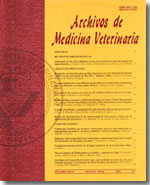Animal welfare indicators to detect problems in the cattle stunning box
Main Article Content
Abstract
The aim of this study was to identify animal welfare problems during the stunning process in a beef slaughtering plant. Animal welfare indicators such as behaviour and handling by the personnel, were evaluated on 1,025 cattle (cows, heifers and steers) during five days of commercial slaughter; cattle were stunned with a non-penetrating captive bolt pistol. A descriptive analysis was used to show the frequencies of the indicators and a Chi-square test to determine the association between some of them. The most frequent behaviours in cattle were struggling (38.3%), vocalization (17.2%) and falling (9.5%). The guillotine door hit 75.1% of cattle on entering the stunning box. On 49.2% of cattle an electric prod was used. Prodding was significantly associated with vocalization (P < 0.001), falling (P = 0.02) and escape attempts (P < 0.001). Most cattle were effectively restrained at the first attempt (92.3%); however in 6.1% of the cases the effective restraint was incorrect, which was significantly associated with vocalization (P < 0.001) and falling (P = 0.01). These results, together with the fact that in only 86.7% of cattle loss of posture was attained after the first shot indicate that there are animal welfare problems during stunning at this plant. It is concluded that some changes in the structure of the stunning box, as well as training of personnel and closer supervision of the process could help in solving the problems found.

